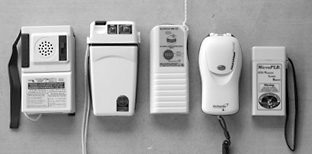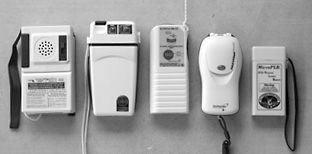
by Douglas S. Ritter
The advantages of 406 MHz alerting over 121.5 MHz are significant and are proven lifesavers. For pilots, the disadvantage of 406 MHz ELTs has always been the expense as we’ll as problems inherent in any fixed ELT installation. Neither is likely to change in the foreseeable future. But now, U.S. pilots have an alternative that provides the benefits of 406 MHz alerting at an affordable price compared to a 406 MHz installed ELT. Its called a personal locator beacon, or PLB for short.
The PLB is a pocket-sized manually operated beacon providing essentially the same alerting capabilities as a 406 MHz ELT for prices starting at $600 and probably a bit less once the initial buying orgy sates demand.
After years of opposition by the FAA, the U.S. Air Force and others, which prevented the sale of PLBs in the U.S., new leadership at the Air Force Rescue Coordination Center has done an about face. This lead the FCC to legalize PLB sale and use in the U.S. as of July 1, 2003.
Alaska Tests
A test program conducted in Alaska since 1994 has resulted in about 400 persons saved with 378 PLBs registered. Many are rentals/loaners used by multiple persons. In 2002, there were 27 rescued in 18 events. Worldwide, where PLBs have been available for years, numerous rescues have resulted from their use. They work.
While some pilots have in the past turned to carrying manually operated 406 MHz EPIRBs (Emergency Position Indicating Radio Beacons, the marine equivalent to an ELT) to gain the advantages of 406 MHz alerting, these are large and cumbersome and not we’ll suited for aviation use. Technically, theyre illegal to use on land, although nobody has ever been prosecuted for using one that way. PLBs, on the other hand, are compact enough to easily carry on your person. The larger ones will fit in a coat or cargo pants pocket or in a belt pouch; the smallest are not much larger than a cigarette pack. As with most electronics, there is an inverse relationship between cost and size. Smaller is more expensive, at least at this juncture.
That a PLB is not tied to the aircraft like an ELT is a major advantage. It can be taken along on any adventure; day hike, backpacking trip, four-wheeling or boating or wherever your interests take you. There’s no need to cut off your arm if you get into trouble and need help.
One PLB has been available in the U.S. for a few years as a Type S (survival) ELT used almost exclusively in life rafts.
The Techtest 500 series ELT is based on a NATO military beacon design and includes duplex comm on 121.5/243 MHz. At press time, Techtest had not determined if they will conform to U.S. PLB standards or if theyll just leave it as an ELT.
The U.S. added two requirements to the international PLB standards. For one, the devices must include a 25 milliwatt 121.5 MHz analog homing signal. This compares to 100 milliwatts for a conventional 121.5 MHz ELT or 50 milliwatts for other PLBs. Second, inserted into the homing signal at the insistence of the FAA is a Morse code P to distinguish a PLB from an ELT.
Sorting Them Out
PLBs can be categorized by various attributes, which in turn affect performance and price. The specifications delineate Class 1 and Class 2 PLBs, the former providing 24 hours of operation at -40-degrees C, the latter 24 hours at -20-degrees C. For most purposes, a Class 2 PLB will be adequate.
Simply keeping it inside your outerwear or packing a self-warming heat pack and some tape or Velcro strip with the beacon will provide most of the benefits of the Class 1 PLB, if needed. The improved cold weather performance of the Class 1 requires a considerably larger battery, adding bulk and weight.
Some PLBs are inherently buoyant. That might be an advantage after a ditching, but a secure tether would also likely suffice. They will not float upright in the transmitting position, like an EPIRB, but neither will they sink to Davy Jones locker.
The most significant performance difference relates to actual location and notification performance. Self-locating beacons use GPS to almost instantaneously transmit your location to the geostationary satellites, which for the most part cover from 70-degrees north to 70-degrees south latitudes. There’s no need to wait until a low-earth-orbit satellite passes overhead to resolve a location via Doppler computations. The location accuracy is also much better, on the order of less than a 300-foot radius versus about a 3-mile radius from 406 MHz locating alone, worst case. Actual results are often better.
Self-locating PLBs may accept GPS coordinates from an external GPS or they may have their own integrated GPS chip and antenna. The former is less expensive; the latter is a simpler and more compact solution, although you will pay a premium for the capability.
GPS is not a panacea and has limitations. Self-locating beacons must be operated optimally for GPS to work to best advantage, or even at all. As with any GPS receiver, the antenna requires a clear sky or minimal overhead cover.
Dense cover, such as a heavy forest canopy, may prevent the GPS receiver from locking up the satellite signals, however the 5-watt 406 MHz distress signal will still punch through almost any cover except granite.
You should set up the beacon for best GPS reception, or, for those connected to an external GPS, ensure that it has acquired the satellites and located itself before turning the beacon on. Orientation is important. As with any handheld GPS, the GPS antenna must point to the sky.
Current PLBs use lithium-based batteries (meeting DOT requirements) with a minimum five-year replacement interval, although actual service life may be longer. As with all 406 MHz beacons, PLBs must be registered, for free, with NOAA.
The chart at left describes PLBs currently COSPAS-SARSAT certified and expected to be available in the U.S. on or shortly after July 1.
Pricing remains a question on some models at our deadline. we’ll have a more in-depth review and evaluation of the beacons in a future issue.
Also With This Article
Click here to view “Checklist.”
Click here to view “PLB Specs Compared.”
Contacts
ACR Electronics
5757 Ravenswood Rd.
Fort Lauderdale, FL 33312
954-981-3333
www.acrelectronics.com
Revere Supply
(McMurdo Pains-Wessex)
3 Fairfield Crescent
West Caldwell, NJ 07066-6204
973-575-8811
www.reveresupply.com
SERPE-IESM (Kannad)
Z.I. des Cinq Chemins
56520 Guidel
France
+33 (0) 2 97 02 49 49
www.serpe-iesm.com
Specmat Technologies
(Techtest Limited)
215 Dunavant Dr.
Rockford, TN 37853
865-609-1411
www.searchandrescue.com
Wireless Concepts Inc.
2263 Ward Ave.
Simi Valley, CA 93065
805-582-9000
www.wireless-concepts.com
Doug Ritter is an Aviation Consumer contributing editor. He edits the non-profit www.equipped.org Web site.





